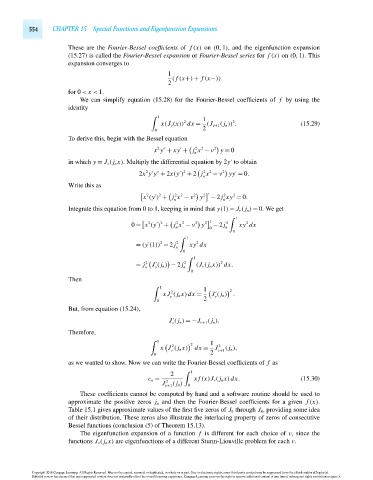Page 574 - Advanced_Engineering_Mathematics o'neil
P. 574
554 CHAPTER 15 Special Functions and Eigenfunction Expansions
These are the Fourier-Bessel coefficients of f (x) on (0,1), and the eigenfunction expansion
(15.27) is called the Fourier-Bessel expansion or Fourier-Bessel series for f (x) on (0,1).This
expansion converges to
1
( f (x+) + f (x−))
2
for 0 < x < 1.
We can simplify equation (15.28) for the Fourier-Bessel coefficients of f by using the
identity
1 1
2
2
x(J ν (x)) dx = (J ν+1 ( j n )) . (15.29)
2
0
To derive this, begin with the Bessel equation
2
2
2
x y + xy + j x − ν 2 y = 0
n
in which y = J ν ( j n x). Multiply the differential equation by 2y to obtain
2
2
2
2
2x y y + 2x(y ) + 2 j x − ν 2 yy = 0.
n
Write this as
2 2 2 2 2 2 2 2
x (y ) + j x − ν y − 2 j xy = 0.
n n
Integrate this equation from 0 to 1, keeping in mind that y(1) = J ν ( j n ) = 0. We get
1
1
2 2 2 2 2 2 2 2
0 = x (y ) + j x − ν y − 2 j xy dx
n 0 n
0
1
2
2
= (y (1)) − 2 j n 2 xy dx
0
1
2
= j 2 J ( j n ) − 2 j 2 (J ν ( j n x)) dx.
n ν n
0
Then
1
2
2 1
xJ ( j n x)dx = J ( j n ) .
ν
ν
0 2
But, from equation (15.24),
J ( j n ) =−J ν+1 ( j n ).
ν
Therefore,
1
2 1
2 2
x J ( j n x) dx = J ( j n ),
ν ν+1
0 2
as we wanted to show. Now we can write the Fourier-Bessel coefficients of f as
2 1
c n = xf (x)J ν ( j n x)dx. (15.30)
2
J ν+1 ( j n ) 0
These coefficients cannot be computed by hand and a software routine should be used to
approximate the positive zeros j n and then the Fourier-Bessel coefficients for a given f (x).
Table 15.1 gives approximate values of the first five zeros of J 0 through J 4 , providing some idea
of their distribution. These zeros also illustrate the interlacing property of zeros of consecutive
Bessel functions (conclusion (5) of Theorem 15.13).
The eigenfunction expansion of a function f is different for each choice of ν, since the
functions J ν ( j n x) are eigenfunctions of a different Sturm-Liouville problem for each ν.
Copyright 2010 Cengage Learning. All Rights Reserved. May not be copied, scanned, or duplicated, in whole or in part. Due to electronic rights, some third party content may be suppressed from the eBook and/or eChapter(s).
Editorial review has deemed that any suppressed content does not materially affect the overall learning experience. Cengage Learning reserves the right to remove additional content at any time if subsequent rights restrictions require it.
October 14, 2010 15:20 THM/NEIL Page-554 27410_15_ch15_p505-562

